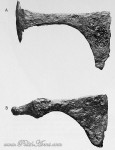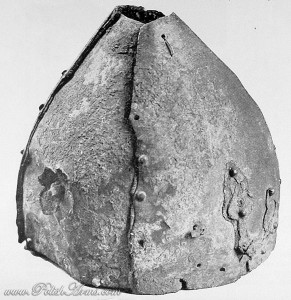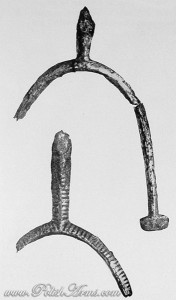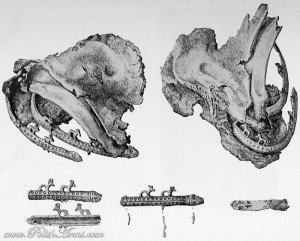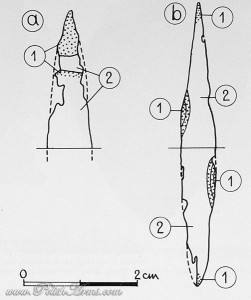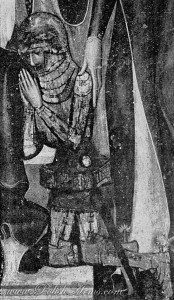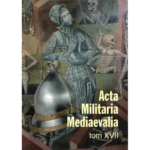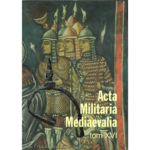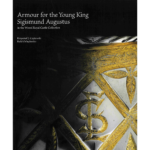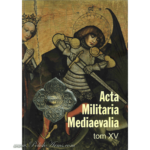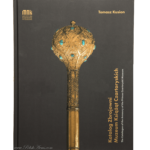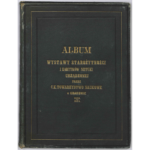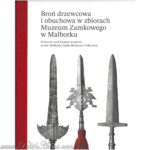
Ancient Polish Arms and Armour – part 1
| ARTICLE | |
 |
‘ANCIENT POLISH ARMS AND ARMOUR’ part 1 by ANDRZEJ NADOLSKI
|
(quoted from The Journal of The Arms and Armour Society, vol. IV, March 1964)
The history of Polish arms and military dress is on the whole very little known in Western Europe. Even the most comprehensive studies published there either do not mention Polonica at all or treat them in only a fragmentary and inaccurate way.[1]
This state of things is primarily due to the fact that Western Europe is apparently little interested in the history of Poland and consequently knows little about it. This is unfortunate, as a knowledge of some of the problems of Polish history is necessary for the proper study and better understanding of some important sections of European history in general. It should be mentioned, however, that the knowledge of the history of Polish arms and armour is very slight even among the Poles themselves. This can be accounted for by the special circumstances that until quite recently made studies in this field extremely difficult. During almost the whole of the 19th century, when in the majority of European countries a scientific approach to the history of arms and armour began to develop, Poland did not enjoy independence, being partitioned among three states: Prussia, Austria, and Tsarist Russia. In consequence, Poland did not have the national army that is the natural protector and often initiator of studies in the history of arms. Another consequence was a limitation, and still more often a complete suppression, of any research into Poland’s military past. All studies of this kind were regarded by the despoilers as attempts at military conspiracy. Even private collections of ancient arms and armour were subjected to many dangers. They were only too often confiscated or, under this pretence, simply robbed by the officials of the partitioning powers. The latest acts of this kind were perpetrated on a large scale by the Nazi authorities during the occupation of 1939-45. [2]
The numerous Polish risings and struggles for independence that took place at the close of the 18th and in the 19th century also led to the depletion of collections of arms and armour. In an emergency, when it was imperative to reinforce a too small regular army or to form an insurgent body, many a specimen of ancient arms was lost on the battle field. This resulted in the rather paradoxical situation that Eastern sabres, for instance, are commoner in Polish collections than the Polish ones of the 16th-18th centuries. [3]
Thus there are many practical reasons for the inadequate knowledge of many aspects of the history of Polish arms and armour, not only abroad but also in Poland. This is a pity, the more so since the territory of Poland was a scene on which the cultural impulses from East and West met and mixed together. Owing to this, the culture of Poland and, within its frame, Polish arms and armour represent a series of local, verycharacteristic forms, not to be found anywhere else and which certainly deserve a closer study. For this reason I wish to express my great gratitude to the Editor of the Journal of the Arms and Armour Society for granting me space in the columns of this excellent periodical to present a brief survey of the historical development of Polish arms and armour. The vastness of the subject forces me to discuss in detail only periods of particular interest, while others will be but briefly sketched.
As a result of archaeological investigations carried out on a broad scale in Poland in the post-war period, our knowledge of Polish culture of the early Middle Ages (6th-12th centuries) has increased tenfold in comparison with what we knew about this subject before 1939. Similarly, far more is now known about early medieval Polish arms and armour. Thus we may state with fair confidence that Polish tribal warriors of the 6th-8th centuries fought mainly on foot, only the wealthier tribal chieftains and their retinue being mounted. They were mainly armed with shields, spears and bows. This state of things, however, was soon subjected to changes. Weapons gradually improved. The cavalry became more and more important. Owing to this, in the 10th-12th centuries, i.e. in the early period of the Polish united state, we may distinguish in the armies of the then reigning Polish kings two different kinds of warrior. The first, less numerous, named in Latin records “loricatus”, is a horseman wearing a helmet, a mail shirt and carrying a shield, a spear and a sword, sometimes supplemented by a battle-axe and a bow. The second kind, dominating in number, is the “clipeatus”, a foot-soldier armed with a spear, a battle-axe (sometimes with a sword), and a bow. [4]
The technological examinations to which a large number of early medieval weapons found in Poland have been submitted, have enabled us to establish with fair certainty that the great majority of Polish arms were of local make. Though seemingly natural, this fact should be emphasized, since even to-day there still subsists the view—advanced once by German scientists—that the Poles, and indeed the Slavs in general, were unskilled in metallurgy and completely dependent for supplies of metal objects on imports from the Frankish state, from Germany, and from Scandinavia. The truth is that only some kinds of weapons were imported from the West and North to early medieval Poland. The imports included mainly swords, which for the most part were made and mounted in the famous centres of iron-working in the Rhineland, but spearheads and battle-axes were only exceptionally introduced from abroad. In addition to imported swords, others made in Poland or at least mounted there, were also used. [5]. All early medieval swords found within the Polish boundaries conform to the types characteristic of North, West, and Central Europe classified by J. Petersen.[6]. Thus we encounter swords of his types B, D, H, J, K, M, R, S, T, Y, Z. They include specimens with nuts richly encrusted with non-ferrous metals (Picture 2). A fine sword of Type T, with quillons and pommel carved in horn, found at Czersko Polskie near Bydgoszcz, was probably mounted in Poland (Picture 3). Most numerous, however, are swords of type X and the so-called “Early Romanesque” ones (in Polish literature on this subject they are also known as type “a”).[7]. The majority of swords, which may be regarded as Polish products, are attributable to the two last types (Picture 1). It should be mentioned here that in the literature on this subject there is a tendency to attribute the origin of the Early Romanesque sword to too late a date.[8]. Swords of this type should be rather dated to the 11th century. This is suggested by the fact that a sword of this type appears in a well-known miniature from the Bible of Otto III, dating from about 1000. [9]
- Picture 01
- Picture 02
- Picture 03
Swords were carried in scabbards. The single specimen of an early medieval sheath so far known from Poland is made of wood covered with linen and leather. It was found in Gdańsk, in habitation layers attributed to the 11th century. [10]. Sometimes the lower end of a sheath was furnished with an ornamented mount of bronze. This form of decoration, however, was only made exceptionally in Poland. The few mounts of this kind found on our lands are imports from Scandinavia or from the Baltic countries.
The sabre, the typical weapon of the Euroasiatic nomads, popular at this time in Hungary and well known in Russia, was not used in earlymedieval Poland. [11]
In Poland during the period under discussion the sword was an expensive weapon which could be afforded only by the wealthier knights or by professional warriors from the duke’s retinue, maintained and armed at his expense. The common kind of weapon, mass produced and universally used, was the battle-axe, sometimes fitted to a long shaft. Apart from simple battle-axes with flat backs, another type equipped with a spike or a hammer on the side opposite to the blade was in use (Picture 4). In an emergency, an ordinary carpenter’s axe was probably also employed as a weapon. The form of battle-axe with an assymmetrical blade furnished with a down-projecting “beard” seems to have been most popular in Poland (Picture 4, A). Axes with symmetrical blades are rare and were probably imported. Specimens inlaid with non-ferrous metals are also exceptional. [12]
Another popular kind of weapon was a spear used alike by horsemen and foot-soldiers, both for throwing and in hand-to-hand fighting. Among the spearheads, those with a rather broad, lancet-like, leaf-shaped head, but massive and romboid in section, clearly predominate. These features were the result of the need to adapt the spearhead for piercing the shields and mail shirts which were gradually becoming more popular. The average length of the spear-shaft was about 2 m. The length has been deduced from the observations made on the size of the grave pits containing warriors, which, during the 11th century, and even exceptionally in the 12th century, were furnished with weapons according to a stillliving pagan tradition. Generally, neither the spearheads nor the battleaxes were decorated. A few exceptions (some inlaid with silver) should be regarded as imports, chiefly from Scandinavia. The so-called “winged” spearheads, a small number of which have been found, were, on the other hand, imported from the Rhineland.[13]
The bow, commonly used by the infantry, played an important part in early medieval warfare. In the 10th-12th centuries it propelled arrows with barbed heads which replaced the lancet-like heads common in the previous centuries (6th-10th). A fragment of a straight wooden bow was found during excavations carried out in Cracow. [14]. The reflexed Eastern bow, however, seems also to have been known in Poland of that period. It was introduced to our lands through contacts with Old Russia and with the nomads from the Black Sea steppes (Pechenegs, Polovtsians). By the 12th century the cross-bow began to spread in Poland, as indicated by bolts, large numbers of which are found on archaeological sites datable to this period. [15]
The shield was undoubtedly the most important item among defensive weapons and was probably used by all kinds of warriors. Unfortunately, not a single specimen has come down to our times, not even any fragments which could provide a basis for reconstruction. The earliest iconographic sources that can be relied upon is provided by the denarii of Bolesław the Bold (1058-1079) which show a horseman carrying a large kite-shaped shield and a lance with a pennon. [16]. Yet it is possible that the denarii are a faithful, unaltered imitation of a foreign (German) model. Even if we could regard them as a trustworthy evidence for the use of the kiteshaped shield in Poland in the mid-11th century (iconographic material from the 12th century is more abundant), there is no doubt that we should admit the possibility of the simultaneous use of the more archaic circular shield. [17]
No example of a hauberk, to which several references are made in written records, has been preserved either. In this respect we fall below our southern neighbours, the Czechs, who can boast of the so-called St. Wenceslaus hauberk in Prague cathedral, and the Russians, who have excavated a few graves with mail shirts dating from the 10th-11th centuries. Though we suppose that the hauberk only was the most popular form of armour in early medieval Poland, we cannot reject the possibility that the Polish warrior may also have worn other kinds of armour, obtained as a result of peaceful or war-like contracts with our Western neighbour.[18]. The iconographic sources (the earliest representations of warriors are on Polish coins of the 12th century) are not clear on this point.
On the other hand, two different forms of helmet from the period under discussion are well-known to us from original finds. First, we should mention the fine, ornamented helmets, formerly classified as the “Great Polish” type (Picture 5).
They have an approximately conical skull consisting of four riveted iron pieces, either gilded or covered with gilded copper sheet. They have no nasals. The skull is surmounted by a socket for a tuft of horse-hair or a plume of feathers. Its sides are ornamented with rosettes. The lower edge of the skull is reinforced by a hoop provided over the forehead with a characteristic decoration resembling a diadem. An aventail, possibly of mail or perhaps of some kind of fabric, was originally fastened to the hoop to protect the neck and a part of the face of a warrior. In Poland, or to be more precise, in Great (i.e. Western) Poland (hence the name of the group), as many as four almost identical helmets of this type have been found. Other identical or at least very similar, specimens have been derived from the territories of former West Prussia (2), from Hungary (1), and from Russia (2). The City of Liverpool Museum owns another specimen—at present on loan to the Tower of London—derived from the unidentified locality “Walric”. In light of recent researches it is accepted that helmets of this type represent a variation on Eastern forms that developed in Russia in the 10th century (perhaps in the region of Cernihov [Tchernikhov]), and thence was introduced to adjacent countries. For this reason it has been suggested that they should be classified as “Helmets of the Cernihov type”. In view of the relatively large concentration of these helmets in the region of Great Poland it seems likely that a secondary centre of their production was active there in the 11th century.[19]
The second type of early medieval helmet is represented by a single example derived from the Lednickie Lake, also in Great Poland (Picture 6).
It is a conical iron helmet, undecorated and furnished with a nasal. In shape it resembles the well-known helmet, attributed to St. Wenceslaus, preserved in Prague Cathedral. [20]. Representations on Polish coins of the 12th century show yet another form of helmet. It is conical with the skull consisting of several pieces and perhaps without a nasal.
The spurs and horse-harness used in Poland in the 10th-12th centuries are relatively well known to us. Due to archaeological investigations a fairly precise chronology of spurs has been established. These include examples beautifully ornamented with silver, copper, and even gold [21] (Picture 7).
Numerous bits, stirrups, and bridle-mounts have also been found. [22]. All these objects show a characteristic and extremely interesting mixture of elements from the West (spurs, stirrups with flat bases, bits without spikes), and East (stirrups with curved bases, bits with spikes, the majority of ornamented bridle-mounts). A unique find is represented by two identical leather saddles (probably on a wooden frame) with ornamented mounts of bronze, doubtlessly of eastern origin (Picture 8). They were discovered at Lutomiersk near Łódź, in an eleventh-century cemetery. [23]
The metallographic and chemical analyses, to which many specimens of various kinds of weapons had been submitted, have revealed some secrets of the technology employed by Polish armourers of the early medieval period. Apart from many other interesting details, the examinations have disclosed that the technology of imported objects differs conspicuously from that of the specimens believed to have been made in Poland. Thus the investigations tested and corroborated several hypotheses based until now on typological analysis of external features alone. Some specimens revealed a surprisingly high level of smithing technique. It appears, for instance, that seemingly quite simple spearheads were sometimes welded from several (3-7) iron and steel strips, differing in hardness and elasticity (Picture 9). There is some evidence that the welding technique and especially that ofwelding together of iron and steel by means of an inserted layer of high-phosphorus iron should be regarded as typical of Polish iron metallurgy in the early Middle Ages. [24]
The metallographical researches that are absolutely indispensable for a really scientific approach to the history of arms and armour, are still in their infancy. Their full importance will not become fully apparent until all countries join in the necessary research and place at our disposal the results of numerous analyses. This will make large-scale comparative studies possible and in consequence will almost certainly lead to the identification of local metal-working techniques. We may hope that our knowledge of the production of early medieval arms and armour and of the contemporary trade in weapons will then acquire new, wide, and attractive prospects.
The 12th century is marked in the history of the Polish arms and armour by a decisive predominance of Western Influences which lasted continuously until the mid-16th century. In Polish strategy and tactics of this period (especially since the 15th century) we observe distinct traits formed under the influence of permanent contacts with the art of war of East European peoples, yet the armour of Polish knights did not differ on the whole from what existed then in the West European countries. Original relics of this period are extremely scanty. This state of affairs is partly the result of the inadequacy of past investigations, especially in the archaeological field. In Poland, as in other countries, the 14th, 15th, and 16th centuries were explored almost exclusively by arthistorians, whose work, though doubtless useful, is quite insufficient to satisfy the demands of a really modern study of arms.
The chief source for our knowledge of Polish arms and armour in the period under discussion are the numerous and varied iconographic relics, including seals (particularly numerous in the 13th century) of Polish princes from the period of division, magnificent grave slabs, religious painting (Picture 10), and the miniatures found in fine-quality manuscripts.
The general picture obtained from all these sources does not differ much from that provided by similar sources in France or England, and particularly in neighbouring Czechoslovakia and Germany. That the similarity of Polish equipment to that used in these countries must have been considerable may be deduced from the fact that before the battle of Grunwald in 1410 King Wladislaw Jagiełło ordered his knights to wind straw-bands round their armours to make the distinction between them and the Teutonic knights more pronounced.[25]
[1]. In support of this statement I will cite the well-known book by H. Knotel and H. Stieg, Handbuch der Uniformkunde (1st edition, Leipzig 1896, 2nd edition, Hamburg, 1937). Glaring errors concerning the arms and dress of the Polish army were corrected only in the 3rd edition (published in 1956) as a result of Polish intervention. Cf. St. Gepner, “Na marginesie trzeciego wydania Handbuch der Uniformkunde” [Notes on the margin of the 3rd edition of “Handbuch der Uniformkunde’*], Arsenał, Vol. I, No. 5 (Cracow, 1958), p. 122.
[2]. The pillage of the collections of the Polish Army Museum in Warsaw, which took place in 1939/40, was conducted by the then Associate Professor at the University of Kiel, SS Obersturmfuhrer Dr. P. Paulsen, author of Axt und Kreuz bei der Nordgermanen, Berlin, 1939 (re-published Bonn, 1956).
[3]. W. Dziewanowski, Zarys dziejów uzbrojenia w Polsce [The history of Polish arms and armour—an outline], Warsaw, 1935, pp. IX-X.
[4]. A. F. Grabski, Polska sztuka wojenna w okresie wczesnofeudalnym [Art of war in early feudal Poland], Warsaw, 1959, pp. 57-68; A. Nadolski, Polskie siły zbrojne w czasach Bolesława Chrobrego. Zarys strategii i taktyki [Polish military forces in the reign of Bolesław the Brave. An outline of strategy and tactics], Łódź, 1956, pp. 27-36; Id.: Studia nad uzbrojeniem polskim w X, XI i XII w. [A study of the Polish arms and armour in the 10th, 11th and 12th centuries], Łódź, 1954 no 99-102.
[5]. A. Nadolski, Studia nad uzbrojeniem . . . p. 31; A. Nadolski, A. Abramowicz, T. Poklewski, Cmentarzysko z XI wieku w Lutomiersku pod Łodzią [An eleventh century cemetery at Lutomiersk near Łódź], Łódź, 1959, p. 51.
[6]. J. Petersen, De norske vikingesverd, Kristiania, 1919.
[7]. A. Nadolski, Studia nad uzbrojeniem .. . pp. 26-28.
[8]. A. Bruhn-Hoffmeyer, Middelalderens tveaeggede svaerd, Kobenhavn, 1954, pp. 36-43.
[9]. A. Nadolski, Studia nad uzbrojeniem . . . p. 28.
[10]. A. Nadolski, “Pochwa miecza znaleziona w osadzie miejskiej z XI wieku w Gdańsku” [A sword-sheath found in an eleventh century urban settlement in Gdańsku], Wiadomości Archeologiczne, Vol. XXII, Warsaw, 1955, No. 2, pp. 186-192.
[11]. A. Nadolski, Studia nad uzbrojeniem . . . pp. 68.
[12]. A. Nadolski, Studia nad uzbrojeniem . . . pp. 36-50.
[13]. A. Nadolski, Studia nad uzbrojeniem . . . pp. 50-60.
[14]. A. Żaki, Sprawozdanie z prac archeologicznych na Wawelu w 1954 r. [Report on
the 1954 archaeological excavation at Wawel], Sprawozdania Archeologiczne Vol. H, Wrocław, 1956, p. 104.
[15]. A. Nadolski, Studia nad uzbrojeniem . . . pp. 60-67.
[16]. A. Nadolski, “Numizmatyczne źródła do dziejów uzbrojenia polskiego w XI wieku” [Numismatic sources to the history of Polish arms and armour in the 11th century], Księga ku czci prof, dr J. Kostrzewskiego, Poznań, in print.
[17]. A. Nadolski, Studia nad uzbrojeniem . . . pp. 75-77.
[18]. A. Nadolski, Studia nad uz rojeniem . . . pp. 77-80.
[19]. A. N. Kirpicnikov, “Russkie ślemy X-XIII”, Sovetskaja Archeologija, No. 4, 1958, pp. 47-69; A. Nadolski, Studia nad uzbrojeniem . . . pp. 70-75; Id., “Uwagi o hełmach typu ‘wielkopolskiego'” [Notes on the helmets of the “Great Polish” type], Prace i Materiały Muzeum Archeologicznego i Etnograficznego w Łodzi, Seria Archeologiczna No. 5, Łódź, 1960, pp. 99-122.
[20]. W. Hensel, Polska przed tysiącem lat [Poland a thousand years ago], Warsaw-Wrocław, 1960, p. 140 and Fig. 130.
[21]. Z. Hilczerówna, Ostrogi polskie z X-XIII wieku [Polish spurs of the 10th-13th centuries], Poznań, 1956.
[22]. A. Nadolski, Studia nad uzbrojeniem … pp. 87-91; A. Nadolski, A. Abramowicz, T. Poklewski, Cmentarzysko z XI wieku w Lutomiersku pod Łodzią [An eleventh century cemetery at Luotmiersk near Łódź], Łódź, 1959, pp. 57-65.
[23]. A. Nadolski, A. Abramowicz, T. Poklewski, op. cit., pp. 57-59.
[24]. J. Piaskowski, “Metaloznawcze badania wyrobów żelaznych” [Metallographic examination of iron objects], appendix to the book; A. Nadolski, A. Abramowicz, T. Poklewski, Cmentarzysko z XI wieku w Lutomiersku . . . pp. 110-139; Id.,”Metaloznawcze badania wczesnośredniowiecznych wyrobów żelaznych na przykładzie zabytków archeologicznych z Łęczycy, Czerchowa i Buczka [Metallographic examinations of medieval iron products made on archaeological relics found on the sites at Łęczyca, Czerchów and Buczek], Studia z dziejów górnictwa i hutnictwa, Vol. III, Wrocław, 1959, pp. 7-102.
[25]. Cronica conflictus Wladislai regis Poloniae cum cruciferis. Anno Christi 1410; ed. Z. Celichowski, Poznań, 1911, p. 22.



